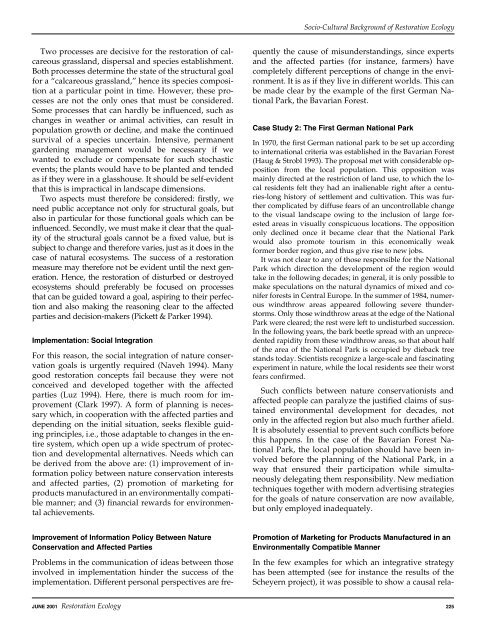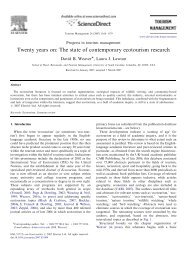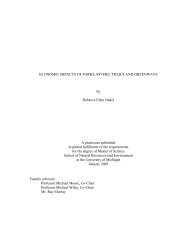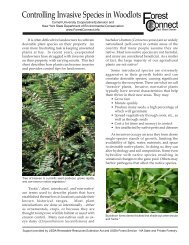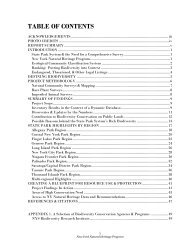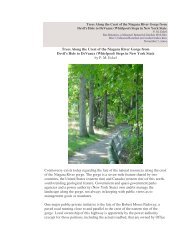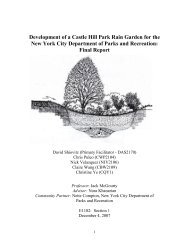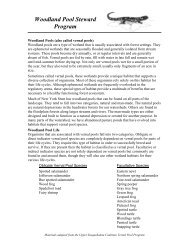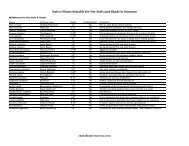Some Remarks on the Socio-Cultural Background of Restoration ...
Some Remarks on the Socio-Cultural Background of Restoration ...
Some Remarks on the Socio-Cultural Background of Restoration ...
You also want an ePaper? Increase the reach of your titles
YUMPU automatically turns print PDFs into web optimized ePapers that Google loves.
<strong>Socio</strong>-<strong>Cultural</strong> <strong>Background</strong> <strong>of</strong> Restorati<strong>on</strong> Ecology<br />
Two processes are decisive for <strong>the</strong> restorati<strong>on</strong> <strong>of</strong> calcareous<br />
grassland, dispersal and species establishment.<br />
Both processes determine <strong>the</strong> state <strong>of</strong> <strong>the</strong> structural goal<br />
for a “calcareous grassland,” hence its species compositi<strong>on</strong><br />
at a particular point in time. However, <strong>the</strong>se processes<br />
are not <strong>the</strong> <strong>on</strong>ly <strong>on</strong>es that must be c<strong>on</strong>sidered.<br />
<str<strong>on</strong>g>Some</str<strong>on</strong>g> processes that can hardly be influenced, such as<br />
changes in wea<strong>the</strong>r or animal activities, can result in<br />
populati<strong>on</strong> growth or decline, and make <strong>the</strong> c<strong>on</strong>tinued<br />
survival <strong>of</strong> a species uncertain. Intensive, permanent<br />
gardening management would be necessary if we<br />
wanted to exclude or compensate for such stochastic<br />
events; <strong>the</strong> plants would have to be planted and tended<br />
as if <strong>the</strong>y were in a glasshouse. It should be self-evident<br />
that this is impractical in landscape dimensi<strong>on</strong>s.<br />
Two aspects must <strong>the</strong>refore be c<strong>on</strong>sidered: firstly, we<br />
need public acceptance not <strong>on</strong>ly for structural goals, but<br />
also in particular for those functi<strong>on</strong>al goals which can be<br />
influenced. Sec<strong>on</strong>dly, we must make it clear that <strong>the</strong> quality<br />
<strong>of</strong> <strong>the</strong> structural goals cannot be a fixed value, but is<br />
subject to change and <strong>the</strong>refore varies, just as it does in <strong>the</strong><br />
case <strong>of</strong> natural ecosystems. The success <strong>of</strong> a restorati<strong>on</strong><br />
measure may <strong>the</strong>refore not be evident until <strong>the</strong> next generati<strong>on</strong>.<br />
Hence, <strong>the</strong> restorati<strong>on</strong> <strong>of</strong> disturbed or destroyed<br />
ecosystems should preferably be focused <strong>on</strong> processes<br />
that can be guided toward a goal, aspiring to <strong>the</strong>ir perfecti<strong>on</strong><br />
and also making <strong>the</strong> reas<strong>on</strong>ing clear to <strong>the</strong> affected<br />
parties and decisi<strong>on</strong>-makers (Pickett & Parker 1994).<br />
Implementati<strong>on</strong>: Social Integrati<strong>on</strong><br />
For this reas<strong>on</strong>, <strong>the</strong> social integrati<strong>on</strong> <strong>of</strong> nature c<strong>on</strong>servati<strong>on</strong><br />
goals is urgently required (Naveh 1994). Many<br />
good restorati<strong>on</strong> c<strong>on</strong>cepts fail because <strong>the</strong>y were not<br />
c<strong>on</strong>ceived and developed toge<strong>the</strong>r with <strong>the</strong> affected<br />
parties (Luz 1994). Here, <strong>the</strong>re is much room for improvement<br />
(Clark 1997). A form <strong>of</strong> planning is necessary<br />
which, in cooperati<strong>on</strong> with <strong>the</strong> affected parties and<br />
depending <strong>on</strong> <strong>the</strong> initial situati<strong>on</strong>, seeks flexible guiding<br />
principles, i.e., those adaptable to changes in <strong>the</strong> entire<br />
system, which open up a wide spectrum <strong>of</strong> protecti<strong>on</strong><br />
and developmental alternatives. Needs which can<br />
be derived from <strong>the</strong> above are: (1) improvement <strong>of</strong> informati<strong>on</strong><br />
policy between nature c<strong>on</strong>servati<strong>on</strong> interests<br />
and affected parties, (2) promoti<strong>on</strong> <strong>of</strong> marketing for<br />
products manufactured in an envir<strong>on</strong>mentally compatible<br />
manner; and (3) financial rewards for envir<strong>on</strong>mental<br />
achievements.<br />
Problems in <strong>the</strong> communicati<strong>on</strong> <strong>of</strong> ideas between those<br />
involved in implementati<strong>on</strong> hinder <strong>the</strong> success <strong>of</strong> <strong>the</strong><br />
implementati<strong>on</strong>. Different pers<strong>on</strong>al perspectives are frequently<br />
<strong>the</strong> cause <strong>of</strong> misunderstandings, since experts<br />
and <strong>the</strong> affected parties (for instance, farmers) have<br />
completely different percepti<strong>on</strong>s <strong>of</strong> change in <strong>the</strong> envir<strong>on</strong>ment.<br />
It is as if <strong>the</strong>y live in different worlds. This can<br />
be made clear by <strong>the</strong> example <strong>of</strong> <strong>the</strong> first German Nati<strong>on</strong>al<br />
Park, <strong>the</strong> Bavarian Forest.<br />
Case Study 2: The First German Nati<strong>on</strong>al Park<br />
In 1970, <strong>the</strong> first German nati<strong>on</strong>al park to be set up according<br />
to internati<strong>on</strong>al criteria was established in <strong>the</strong> Bavarian Forest<br />
(Haug & Strobl 1993). The proposal met with c<strong>on</strong>siderable oppositi<strong>on</strong><br />
from <strong>the</strong> local populati<strong>on</strong>. This oppositi<strong>on</strong> was<br />
mainly directed at <strong>the</strong> restricti<strong>on</strong> <strong>of</strong> land use, to which <strong>the</strong> local<br />
residents felt <strong>the</strong>y had an inalienable right after a centuries-l<strong>on</strong>g<br />
history <strong>of</strong> settlement and cultivati<strong>on</strong>. This was fur<strong>the</strong>r<br />
complicated by diffuse fears <strong>of</strong> an unc<strong>on</strong>trollable change<br />
to <strong>the</strong> visual landscape owing to <strong>the</strong> inclusi<strong>on</strong> <strong>of</strong> large forested<br />
areas in visually c<strong>on</strong>spicuous locati<strong>on</strong>s. The oppositi<strong>on</strong><br />
<strong>on</strong>ly declined <strong>on</strong>ce it became clear that <strong>the</strong> Nati<strong>on</strong>al Park<br />
would also promote tourism in this ec<strong>on</strong>omically weak<br />
former border regi<strong>on</strong>, and thus give rise to new jobs.<br />
It was not clear to any <strong>of</strong> those resp<strong>on</strong>sible for <strong>the</strong> Nati<strong>on</strong>al<br />
Park which directi<strong>on</strong> <strong>the</strong> development <strong>of</strong> <strong>the</strong> regi<strong>on</strong> would<br />
take in <strong>the</strong> following decades; in general, it is <strong>on</strong>ly possible to<br />
make speculati<strong>on</strong>s <strong>on</strong> <strong>the</strong> natural dynamics <strong>of</strong> mixed and c<strong>on</strong>ifer<br />
forests in Central Europe. In <strong>the</strong> summer <strong>of</strong> 1984, numerous<br />
windthrow areas appeared following severe thunderstorms.<br />
Only those windthrow areas at <strong>the</strong> edge <strong>of</strong> <strong>the</strong> Nati<strong>on</strong>al<br />
Park were cleared; <strong>the</strong> rest were left to undisturbed successi<strong>on</strong>.<br />
In <strong>the</strong> following years, <strong>the</strong> bark beetle spread with an unprecedented<br />
rapidity from <strong>the</strong>se windthrow areas, so that about half<br />
<strong>of</strong> <strong>the</strong> area <strong>of</strong> <strong>the</strong> Nati<strong>on</strong>al Park is occupied by dieback tree<br />
stands today. Scientists recognize a large-scale and fascinating<br />
experiment in nature, while <strong>the</strong> local residents see <strong>the</strong>ir worst<br />
fears c<strong>on</strong>firmed.<br />
Such c<strong>on</strong>flicts between nature c<strong>on</strong>servati<strong>on</strong>ists and<br />
affected people can paralyze <strong>the</strong> justified claims <strong>of</strong> sustained<br />
envir<strong>on</strong>mental development for decades, not<br />
<strong>on</strong>ly in <strong>the</strong> affected regi<strong>on</strong> but also much fur<strong>the</strong>r afield.<br />
It is absolutely essential to prevent such c<strong>on</strong>flicts before<br />
this happens. In <strong>the</strong> case <strong>of</strong> <strong>the</strong> Bavarian Forest Nati<strong>on</strong>al<br />
Park, <strong>the</strong> local populati<strong>on</strong> should have been involved<br />
before <strong>the</strong> planning <strong>of</strong> <strong>the</strong> Nati<strong>on</strong>al Park, in a<br />
way that ensured <strong>the</strong>ir participati<strong>on</strong> while simultaneously<br />
delegating <strong>the</strong>m resp<strong>on</strong>sibility. New mediati<strong>on</strong><br />
techniques toge<strong>the</strong>r with modern advertising strategies<br />
for <strong>the</strong> goals <strong>of</strong> nature c<strong>on</strong>servati<strong>on</strong> are now available,<br />
but <strong>on</strong>ly employed inadequately.<br />
Improvement <strong>of</strong> Informati<strong>on</strong> Policy Between Nature<br />
C<strong>on</strong>servati<strong>on</strong> and Affected Parties<br />
Promoti<strong>on</strong> <strong>of</strong> Marketing for Products Manufactured in an<br />
Envir<strong>on</strong>mentally Compatible Manner<br />
In <strong>the</strong> few examples for which an integrative strategy<br />
has been attempted (see for instance <strong>the</strong> results <strong>of</strong> <strong>the</strong><br />
Scheyern project), it was possible to show a causal rela-<br />
JUNE 2001 Restorati<strong>on</strong> Ecology 225


